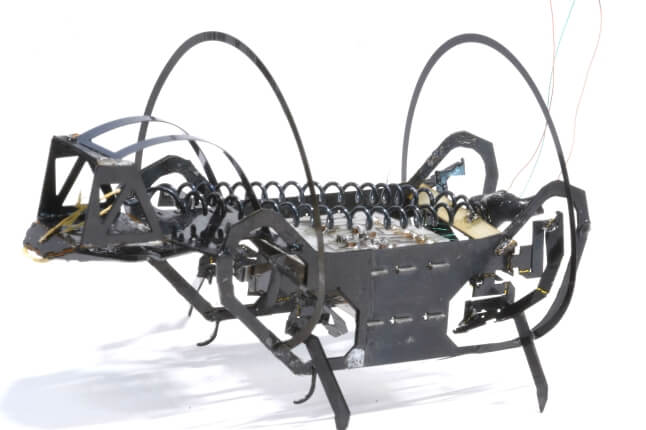News
People rarely walk at a constant speed and a single incline. We change speed when rushing to the next appointment, catching a crosswalk signal, or going for a casual stroll in the park. Slopes change all the time too, whether we’re going for a hike or up a ramp into a building. In addition to environmental variably, how we walk is influenced by sex, height, age, and muscle strength, and sometimes by neural or muscular disorders such as stroke or Parkinson’s Disease.
This human and task variability is a major challenge in designing wearable robotics to assist or augment walking in real-world conditions. To date, customizing wearable robotic assistance to an individual’s walking requires hours of manual or automatic tuning — a tedious task for healthy individuals and often impossible for older adults or clinical patients.
Now, researchers from the Harvard John A. Paulson School of Engineering and Applied Sciences (SEAS) have developed a new approach in which robotic exosuit assistance can be calibrated to an individual and adapt to a variety of real-world walking tasks in a matter of seconds. The bioinspired system uses ultrasound measurements of muscle dynamics to develop a personalized and activity-specific assistance profile for users of the exosuit.
“Our muscle-based approach enables relatively rapid generation of individualized assistance profiles that provide real benefit to the person walking,” said Robert D. Howe, the Abbott and James Lawrence Professor of Engineering, and co-author of the paper.
The research is published in Science Robotics.
Previous bioinspired attempts at developing individualized assistance profiles for robotic exosuits focused on the dynamic movements of the limbs of the wearer. The SEAS researchers took a different approach. The research was a collaboration between Howe’s Harvard Biorobotics Laboratory, which has extensive experience in ultrasound imaging and real-time image processing, and the Harvard Biodesign Lab, run by Conor J. Walsh, the Paul A. Maeder Professor of Engineering and Applied Sciences at SEAS, which develops soft wearable robots for augmenting and restoring human performance.
The research team strapped a portable ultrasound system to the calves of participants and imaged their muscles as they performed a series of walking tasks. (Credit: The Harvard Biodesign Lab/Harvard SEAS)
Download Image
“We used ultrasound to look under the skin and directly measured what the user’s muscles were doing during several walking tasks,” said Richard Nuckols, a Postdoctoral Research Associate at SEAS and co-first author of the paper. “Our muscles and tendons have compliance which means there is not necessarily a direct mapping between the movement of the limbs and that of the underlying muscles driving their motion.”
The research team strapped a portable ultrasound system to the calves of participants and imaged their muscles as they performed a series of walking tasks.
“From these pre-recorded images, we estimated the assistive force to be applied in parallel with the calf muscles to offset the additional work they need to perform during the push off phase of the walking cycle,” said Krithika Swaminathan, a graduate student at SEAS and the Graduate School of Arts and Sciences (GSAS) and co-first author of the study.
The new system only needs a few seconds of walking, even one stride may be sufficient, to capture the muscle’s profile.
For each of the ultrasound-generated profiles, the researchers then measured how much metabolic energy the person used during walking with and without the exosuit. The researchers found that the muscle-based assistance provided by the exosuit significantly reduced the metabolic energy of walking across a range of walking speeds and inclines.
The exosuit also applied lower assistance force to achieve the same or improved metabolic energy benefit than previous published studies.
“By measuring the muscle directly, we can work more intuitively with the person using the exosuit,” said Sangjun Lee, a graduate student at SEAS and GSAS and co-first author of the study. “With this approach, the exosuit isn’t overpowering the wearer, it’s working cooperatively with them.”
When tested in real-world situations, the exosuit was able to quickly adapt to changes in walking speed and incline.
Next, the research team aims to test the system making constant, real-time adjustments.
“This approach may help support the adoption of wearable robotics in real-world, dynamic situations by enabling comfortable, tailored, and adaptive assistance,” said Walsh, the senior author of the paper.
This research was also co-authored by Dorothy Orzel. It was supported by National Institutes of Health grants BRG-R01HD088619, U01TR002775 and R21AR076686, National Science Foundation grant CMMI-1925085.
Topics: Robotics
Cutting-edge science delivered direct to your inbox.
Join the Harvard SEAS mailing list.
Scientist Profiles
Robert D. Howe
Abbott and James Lawrence Professor of Engineering
Conor J Walsh
Paul A. Maeder Professor of Engineering and Applied Sciences
Press Contact
Leah Burrows | 617-496-1351 | lburrows@seas.harvard.edu




